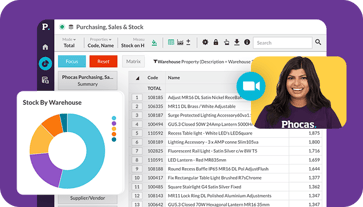Seasonal stock control trends: Do you have your products ready?
At this time of year many businesses are dealing with seasonal demands and stock control. Seasonal trends come in many forms: increased sales of wine for the holidays, increased sales in HVAC systems during the northern hemisphere summer, or increased sales of ski gear in the southern hemisphere winter.
Regardless of the seasonal trend your business is dealing with, the key to success for a distribution business is to have the right product, in the right place, at the right time. In American terms, sending products from the Allentown warehouse to Philadelphia when your Pittsburgh branch is running low isn't going to increase sales.
Seasonal trends: Know what is likely to happen
Planning for seasonal trends consist mainly of three metrics:
1. How much did you sell in previous years during this season?
and:
2. How much have you sold year-on-year?
and a third in case of an unexpected circumstance.
3. How much did you sell in an outlier year when the weather was unseasonably favourable or not? or when a savvy new competitor landed.
These three metrics alone should give you an idea of what to expect. Perhaps, at a company level, your sales have increased. However, dig deeper and break these trends down by region and by branch. You might find that your branch in one region has seen a phenomenal increase in sales, while another has remained stable or even declined. There are measures you can take to remedy declining sales, but for now it may be wise to send more stock to your well-performing branch.
Other metrics you might consider are performance per product line or type, performance per sales rep, or even per marketing campaign.
Seasonal trends:Stay agile
While it is important to know what is likely to happen, it is perhaps just as important to be able to adjust to change. Factors outside of your control, such as a cold spell or heatwave, can impact your sales. This is both a challenge and an opportunity. It might be a challenge in that you do not have the quantities of products needed to meet demands. However, it is an opportunity in that your competitors did not plan for the unexpected event either. This means that, if your business can produce or purchase the right product fast enough, you may be able to win business from your competitors.
By staying on top of your business data you can spot these trends and act fast. Don’t wait until you’re out of product to realize you need to increase your order: see the trend emerging and order more before you run out.
Seasonal trends: Analyze your data in minutes
Does it take hours, if not days or weeks, to get seasonal sales insight across your business? With traditional reporting directly from ERP, CRM, and other data sources, that is often the case. These types of reports often require the IT teams to create the reports. Going back and forth with these teams to drill into your data is time-consuming for both parties, and often something that simply does not fit into a busy workday. On top of that, you might have to combine data from different sources and reports in spreadsheets. This again is time-consuming but also leaves room for error. A small error can easily be made in a spreadsheet, no matter how competent the person combining the data is. And needless to say, a misplaced comma or extra zero in a number or formula can have large impacts on how the data is interpreted.
With data analytics solutions designed for inventory management , you can track metrics that are important to your business, and create reports in seconds or minutes. By logging on to your Phocas home screen, you can quickly get an idea of how you are tracking on your chosen metrics. Clicking through these visual representations will take you to a grid where you can query the data following your train of thought. You don’t have to wait for IT, you don’t have to combine data in a spreadsheet, and importantly; you cannot accidentally break or delete any data.


Empowering businesses with intuitive data analytics, driving informed decisions for growth and profitability. We make people feel good about data.
Related blog posts

Manufacturers, distributors and retailers rely heavily on their suppliers to deliver quality products on time and at the right price. Strong supplier relationship management (SRM) is essential for these industries because it enables you and your suppliers to map out the supply chain, achieve economies of scale and offer customers an extensive choice of products.
Read more
DIFOT (Delivered In-Full, On-Time) or OTIF (On-Time In-Full) is a fundamental KPI when analyzing the performance of your supply chain. The main goal is to get your customers the products they need, when they need them, in the quantity they ordered. DIFOT measures how successful your business is at achieving this objective and identifies procurement problems and supplier reliability.
Read more
The U.S. wholesale distribution sector is experiencing a rapid acceleration in mergers & acquisitions (M&A) activity. From HVAC buying groups like Johnstone Supply acquiring independents, to family-owned distributors selling due to succession challenges, consolidation is reshaping the distribution landscape. One recent example is Hein Electric Supply's acquisition of Laser Electric Supply highlights how strategic buyers are capitalizing on opportunities across the middle market.
Read more
The Spring 2025 Fortune/Deloitte CEO Survey presents a consistent story of boardrooms experiencing a sense of cautious optimism controlled by an emphasis on fiscal responsibility. This is playing out with 42% of CEOs saying they want their teams to focus on cost-cutting measures without raising prices to avoid losing their customers.
Read moreBrowse by category

Find out how our platform gives you the visibility you need to get more done.
Get your demo today